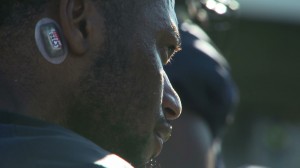
X2 impact sensors were used in Ole Miss spring football practice to document head impact during plays.
OXFORD, Miss. – The University of Mississippi is continuing its pioneering concussion research collaboration with X2 Biosystems this fall as scientists and trainers monitor student-athletes in real time to collect data from on-field collisions.
This season, 20 Ole Miss Rebel football players are wearing an “xPatch” device, designed by X2 Biosystems, behind their ears during games. This chip registers any impact made to the athlete’s head.
The overall goal of the project, which is a partnership between the Ole Miss Department of Intercollegiate Athletics, the university’s departments of Electrical Engineering and Nutrition and Hospitality Management, its Division of Outreach and X2 Biosystems, is to find ways to be proactive in preventing concussions. This can be achieved through teaching proper playing form, nutrition and hydration, said Matt Morrison, a UM assistant professor of electrical engineering.
A few football players from several positions were chosen to wear the xPatch, including defensive backs, linebackers, offensive lineman, receivers and running backs, said Shannon Singletary, senior associate athletics director for health and sports performance.
The data collected so far shows the number of impacts to the head the player receives during practice and the amount of force behind that hit.
“We are also able to determine what part of the head is hit,” Singletary said. “If we see a player is hitting with the right side of his head, we can coach him to get his head up. In an immediate practical use, it’s become an educational tool to help them with tackling technique.”
The Ole Miss women’s soccer team is finalizing preliminary preparations to join the study and players should begin wearing the chips within a few weeks.
“We would like to continue to study this,” he said. “We think it’s important. We’re in this study for the long haul, or as long as they continue to choose us.”
This summer, 16 high school students from across the nation helped lay the foundation for the development of an application that will assist athletic trainers, sports dietitians and doctors by storing data, nutrition information and even the academic schedules of each student-athlete. The app, still in its early stages, is designed to improve the communication between doctors, trainers, coaches and professors, Morrison said.
The next stages involve monitoring 20 football players who wear the chip and outfitting Vaught-Hemingway Stadium with a new generation of technology for improved data collection, Morrison said.
“Our goal is to improve the relaying of information,” he said. “Some of the major challenges in the health of athletes are that there are pieces of information that aren’t linked. For example, the concussion data portion of the app will allow an easy flow of communication between athletic trainers and doctors.”
Because an athlete’s classwork and/or educational commitments may also suffer during the concussion healing process, proper steps must be taken to make sure the affected athletes have proper academic accommodations, including holding them out of class or decreasing their light exposure.
Communicating that information to professors is vital. Studies indicate that on average, a student-athlete with a concussion who misses two or more weeks of game play experiences a 0.3 drop in grade-point average that semester, Morrison said. By properly notifying professors, appropriate assistance could be provided to injured athletes in order to maintain classroom performance.
“By integrating the app with concussion research, we are able to have a multidisciplinary research project that meets the mission of the University of Mississippi and Ole Miss athletics, and to meet Athletics Director Ross Bjork’s vision for being on the forefront of student-athlete athletic and academic achievement,” he said.
Nutrition is another essential part of concussion recovery, said Melinda Valliant, co-director of the UM Center for Health and Sport Performance and co-principal investigator on the project.
“The importance of an individual’s hydration and nutritional status on concussion severity and recovery is a research area that is in its infancy now,” she said. “We want to collect data that drive the development of best practice in educating athletes at all levels regarding nutritional needs to not only improve their performance, but to help keep them healthy.”
“In a short period of time, Matt Morrison and his colleagues at Ole Miss have been able to establish a remarkable interdisciplinary research and teaching program that is addressing many important facets of concussions,” said John Ralston, CEO of X2 Biosystems. “X2 is excited to be collaborating with Ole Miss on topics that include stadiumwide secure wireless connectivity for wearable impact sensors, the development of safer playing and practice techniques, the role of athlete nutrition in concussion injury risk, and STEM teaching opportunities that leverage wearable sensor and computing technologies as a vehicle to engage young students.”
High schools from across the state are also participating in the research, with support from the Mississippi High School Activities Association and Oxford-based Mind Matters Foundation. Gulfport High School, Hattiesburg High School, Clinton High School, Booneville High School and Lewisburg High School all have student-athletes wearing the xPatch chips during the 2015-2016 school year, in an effort to help develop economically viable concussion-safety programs for the tens of millions of young athletes who benefit from participating in sporting activities, but at the same time are exposed to a wide variety of impact-related concussion risks.